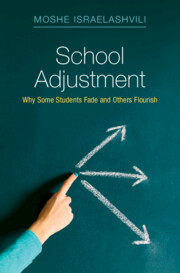Book contents
- School Adjustment
- School Adjustment
- Copyright page
- Dedication
- Contents
- Figures
- Tables
- Preface
- Acknowledgments
- Chapter 1 School Adjustment
- Chapter 2 What Does the Term “School” Stand For?
- Chapter 3 Flourish …? … In School …?!
- Chapter 4 Definition of School Adjustment
- Chapter 5 Early Screening for School Readiness
- Chapter 6 Elementary School Adjustment
- Chapter 7 Adjustment to Middle School
- Chapter 8 Adjustment to High School
- Chapter 9 How Should School Adjustment Be Measured?
- Chapter 10 Expressions of School Maladjustment
- Index
- References
Chapter 3 - Flourish …? … In School …?!
Published online by Cambridge University Press: 29 August 2025
- School Adjustment
- School Adjustment
- Copyright page
- Dedication
- Contents
- Figures
- Tables
- Preface
- Acknowledgments
- Chapter 1 School Adjustment
- Chapter 2 What Does the Term “School” Stand For?
- Chapter 3 Flourish …? … In School …?!
- Chapter 4 Definition of School Adjustment
- Chapter 5 Early Screening for School Readiness
- Chapter 6 Elementary School Adjustment
- Chapter 7 Adjustment to Middle School
- Chapter 8 Adjustment to High School
- Chapter 9 How Should School Adjustment Be Measured?
- Chapter 10 Expressions of School Maladjustment
- Index
- References
Summary
Many, especially school students themselves, would wonder what the connection is between school attendance and personal flourishing. This chapter advocates that students’ flourishing is a major goal of any educational system around the globe, and that the importance of flourishing is rooted more in its psychological – character-wise – aspects and not only in its intellectual aspects. There are many definitions of being in a state of flourishing (e.g., self-confidence, mental and emotional well-being, positive emotions, positive social behavior, cognitive and academic development, curiosity, a sense of meaning and purpose, etc.). The primary claim of this book is that school adjustment is a springboard to personal flourishing and a satisfying life as an adult. Two crucial issues emerge: (a) to what extent school settings enable it and (b) whether teachers’ training programs (e.g., in higher education) devote time, resources, and opportunities to training candidate teachers in supporting school students’ flourishing
Keywords
Information
- Type
- Chapter
- Information
- School AdjustmentWhy Some Students Fade and Others Flourish, pp. 36 - 58Publisher: Cambridge University PressPrint publication year: 2025
References
Accessibility standard: Inaccessible, or known limited accessibility
Content Navigation
Allows you to navigate directly to chapters, sections, or non‐text items through a linked table of contents, reducing the need for extensive scrolling.
Provides an interactive index, letting you go straight to where a term or subject appears in the text without manual searching.
Reading Order & Textual Equivalents
You will encounter all content (including footnotes, captions, etc.) in a clear, sequential flow, making it easier to follow with assistive tools like screen readers.
You get concise descriptions (for images, charts, or media clips), ensuring you do not miss crucial information when visual or audio elements are not accessible.
You get more than just short alt text: you have comprehensive text equivalents, transcripts, captions, or audio descriptions for substantial non‐text content, which is especially helpful for complex visuals or multimedia.
Visual Accessibility
You will still understand key ideas or prompts without relying solely on colour, which is especially helpful if you have colour vision deficiencies.
Structural and Technical Features
You gain clarity from ARIA (Accessible Rich Internet Applications) roles and attributes, as they help assistive technologies interpret how each part of the content functions.
